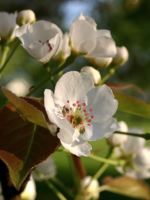Mon-Fri 9am - 5pm Mountain time
Balsam Poplar vs Ussurian Pear (Siberian)
Populus balsamifera
Pyrus ussuriensis
NOT AVAILABLE THIS SEASON - MIGHT RETURN
Balsam Poplar is a hardy, fast-growing deciduous tree that is Native to Canada east of the Rockies.
We grow them in two variations. Sometimes they are a male clones, so they don't produce fluff. Other times, we grow them from seed, which will result in fluff. The detailed descriptions (see below) will tell you which is which.
Ussurian Pear is the most cold hardy of all pear species. It is frequently used as a rootstock or as a pollinizer for other pear varieties. The pinkish-white flowers that bloom in the spring and the striking fall colours make it well-suited as an ornamental addition to your landscape.
Ussurian Pear can also be used for forming hedges as it tends to branch quite low.
While the Ussurian Pear is considered self-pollinating, planting with another pear variety will increase yields. Can be paired with Krazulya Pear or Beedle Pear.
Balsam Poplar Quick Facts
Ussurian Pear (Siberian) Quick Facts
In row spacing: 2.4 - 3 m (8 - 10 ft)

